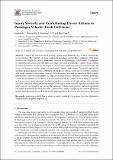Injury Severity and Contributing Driver Actions in Passenger Vehicle–Truck Collisions
Author(s)
Xu, Jingjing; Wali, Behram; Li, Xiaobing; Yang, Jiaqi
Downloadijerph-16-03542.pdf (997.2Kb)
Terms of use
Metadata
Show full item recordAbstract
Large-scale truck-involved crashes attract great attention due to their increasingly severe injuries. The majority of those crashes are passenger vehicle–truck collisions. This study intends to investigate the critical relationship between truck/passenger vehicle driver’s intentional or unintentional actions and the associated injury severity in passenger vehicle–truck crashes. A random-parameter model was developed to estimate the complicated associations between the risk factors and injury severity by using a comprehensive Virginia crash dataset. The model explored the unobserved heterogeneity while controlling for the driver, vehicle, and roadway factors. Compared with truck passengers, occupants in passenger vehicles are six times and ten times more likely to suffer minor injuries and serious/fatal injuries, respectively. Importantly, regardless of whether passenger vehicle drivers undertook intentional or unintentional actions, the crashes are more likely to associate with more severe injury outcomes. In addition, crashes occurring late at night and in early mornings are often correlated with more severe injuries. Such associations between explanatory factors and injury severity are found to vary across the passenger vehicle–truck crashes, and such significant variations of estimated parameters further confirmed the validity of applying the random-parameter model. More implications based on the results and suggestions in terms of safe driving are discussed.
Date issued
2019-09Department
Massachusetts Institute of Technology. SENSEable City LaboratoryJournal
International Journal of Environmental Research and Public Health
Publisher
MDPI AG
Citation
Xu, Jingjing et al. "Injury Severity and Contributing Driver Actions in Passenger Vehicle–Truck Collision." International Journal of Environmental Research and Public Health 16, 19 (September 2019): 3542 © The Author(s)
Version: Final published version
ISSN
1660-4601